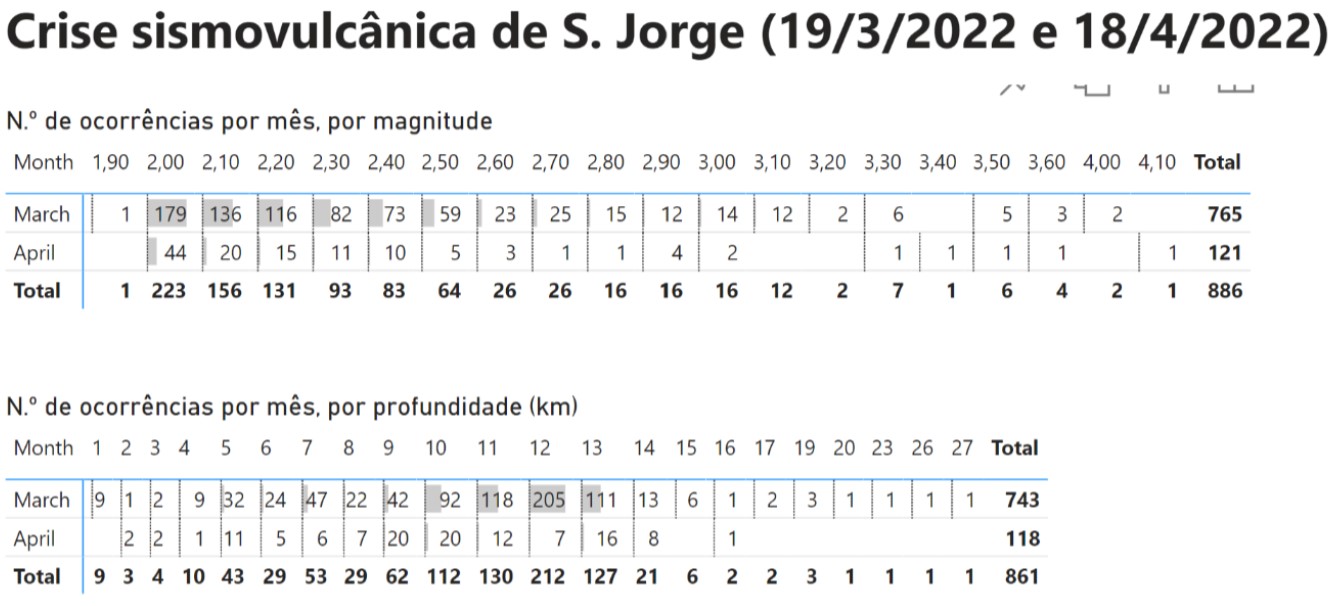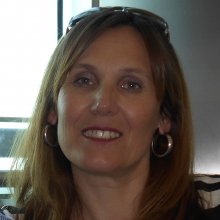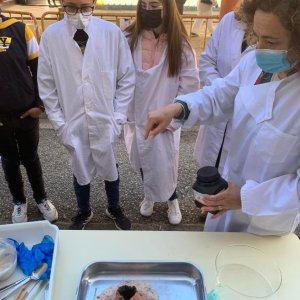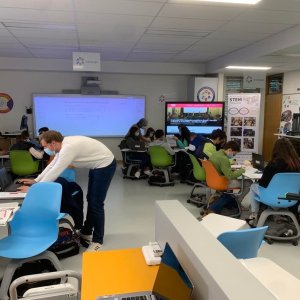Why does the Earth shake in the Azores? From the São Jorge seismic-volcanic crisis to blue carbon

Activity description
In this activity, content related to the topic of earthquakes is explored, starting from a real-world issue – the seismic-volcanic crisis in the Azores (São Jorge) in April 2022.
This activity explores content related to the topic of earthquakes, using a real-life scenario – the seismic-volcanic crisis in the Azores (São Jorge) in April 2022. Volcanic activity is also responsible for the release of gases such as carbon dioxide, so students will be challenged to explore and analyze ways to sequester this gas using blue carbon agriculture. To ensure better integration of different learning areas, as well as appropriate support for various difficulties that may arise, this activity will be carried out in co-teaching mode with Natural Sciences, Physics and Chemistry, and Mathematics teachers.
Laboratory materials:
-
Ammonium dichromate
-
Sugar
-
Salt
-
Iron filings
-
Phosphorus
-
“Volcano cone”
-
8 computers and 8 tablets
-
KMZ file with data on the Sumatra earthquake
-
Power BI file
-
RTP video on the seismic situation in the Azores
Power BI preparation with data on earthquakes in the Azores during the seismic-volcanic crisis, using the IPMA website.
Student profiles
Essential learnings
Please download the following files:
Ficheiros
Sumatra_2004.kmz (689.12 KB)Activity guides
Activity Introduction
The current seismic situation in the Azores is presented using the RTP Açores video from March 21, 2022, “Sismos em S. Jorge são de origem tectónica”.
The island’s location is shown on Google Earth, and some measurements are taken, such as the distance to Mangualde.

A discussion with students is held based on questions such as:
-
After watching the previous video, explain in your own words what “earthquake magnitude” might mean.
-
Is the magnitude of the earthquakes that occurred enough to cause damage to buildings? Would the damage be the same in different types of buildings?
-
What can carbon dioxide values in the soil tell us?
-
Has the number (frequency) of earthquakes increased in the last few days of the period mentioned in the video? And how has their magnitude changed?
-
If a volcanic eruption occurs and there is a large release of CO₂, is it possible to “sequester” or “capture” this gas?
The Student Guide is distributed, and the initial situation is explored. Questions include:
-
What is the name of the situation occurring on São Jorge Island? What are its causes? Why is it concerning?
-
What was the highest magnitude recorded so far?
-
After reading the introductory text, can you explain what “magnitude” and “intensity” of an earthquake are? (Students are informed that the first question in the Student Guide involves research on these concepts and that their answers will be validated during that moment.)
Activity Development
After reading the initial situation, students are divided into four groups and asked to complete the tasks proposed in the Student Guide. Each group can start at a different point of the guide.
Point A – Natural Sciences
In this part, students research the terms “magnitude” and “intensity” of an earthquake.
In question 2 of the Student Guide (point A), students are asked to open the KMZ file with data on the Sumatra earthquake and analyze:
-
The location of the epicenter
-
The magnitude of the Sumatra earthquake
-
The number of deaths in Indonesia and more distant locations
-
The distance between the epicenter and, for example, Sri Lanka, and how that relates to the number of deaths
Point B1 – Physics and Chemistry
The relationship between CO₂ and the greenhouse effect is discussed with reference to the introductory text.
Students analyze the gas emissions from the Cumbre Vieja volcano, in the Canary Islands.
The word equation for the CO₂ sequestration process in the oceans is explored.
Point B2 – Physics and Chemistry & Natural Sciences
Each group is asked to carry out the practical activity outside the classroom. One student reads the instructions in point B2 of the Student Guide.
Using the proper materials, two or three students perform the activity with the teacher’s support. The remaining students record the results.
The teacher may also simulate a volcanic eruption using only ammonium dichromate and a heat source to introduce the concept of thermolysis.
After returning to the classroom, conclusions are discussed.
Point C1 – Mathematics
With Power BI support, students explore data on the magnitude and depth of the focus (hypocenter) of the earthquakes that occurred in the Azores up to that point.

Students are asked to analyze the data presented in Power BI on their computers. They are to formulate questions for interpreting the data using the available filters and perform various calculations, such as determining the average and mode of seismic magnitudes over the last 5 days.
Point C2 – Mathematics
Students are informed that the use of seaweed for CO₂ sequestration is a recent research area, with new studies, tech startups, and bank funding lines emerging.
Based on the provided data, students are asked to calculate the amount of dried seaweed that would be needed to sequester a given amount of CO₂ (see the Student Guide – point C2).
Activity Conclusion
To wrap up the activity, students are invited to write an informative text, justifying—based on their calculations—how blue carbon agriculture could be beneficial for the Municipality of Mangualde, highlighting potential local economic development opportunities.
Students should apply knowledge about the importance of seaweed in CO₂ sequestration, as well as its possible uses as fertilizer or animal feed, for example.
Extension Activity
-
Model an evacuation plan for the most affected areas using InoBot.
-
Use InoBot/Scratch to simulate a boat traveling between different islands.
-
Analyze usual maritime routes and port locations.
These extension activities allow students to:
-
Explore triangles
-
Formulate conjectures about angle measures and opposite side lengths
-
Recall that the sum of the interior angles in a triangle is 180º
-
Establish a relationship between an exterior angle and the sum of the non-adjacent interior angles
Essential learnings
Evidence / Student action
- Discutir medidas de proteção de bens e de pessoas, antes, durante e após um sismo, bem como a importância da ciência e da tecnologia na previsão sísmica.
- Questionamento oral sobre o vídeo; Questão 1.3 e 1.4 do ponto A do Guião do aluno.
- Explicar a distribuição dos sismos e dos vulcões no planeta Terra, tendo em conta os limites das placas tectónicas.
- Discussão em grande grupo partindo da observação da localização dos Açores com recurso ao Google Earth.
- Identificar, laboratorialmente e no dia a dia, transformações químicas através da junção de substâncias, por ação mecânica, do calor, da luz, e da eletricidade.
- Realização da atividade prática - simulação de um vulcão em erupção.
- Analisar e interpretar informação contida num conjunto de dados recorrendo às medidas estatísticas mais adequadas (mediana, média, moda) e reconhecer o seu significado no contexto de uma dada situação.
- Resolução do ponto C1 do Guião do Aluno.
- Resolução de problemas - Processo - Reconhecer e aplicar as etapas do processo de resolução de problemas.
- Resolução do ponto C1 do Guião do Aluno.
- Aplicar ideias matemáticas na resolução de problemas de contextos diversos (outras áreas do saber, realidade, profissões).
- Resolução da parte das conclusões do Guião do Aluno.
- Reconhecer a presença de funções de proporcionalidade direta em situações, estudadas noutras disciplinas, estabelecendo conexões matemáticas entre temas matemáticos e com outras áreas do saber.
- Resolução de propostas apresentadas em C2 e na alínea a das conclusões do Guião do Aluno.
Connell, H. (2022). The Ocean and Carbon Sequestration: Leveraging the Ocean’s Carbon Capture Potential. In The Emerald Review @ Boston University, acedido em http://emeraldreview.com/the-ocean-and-carbon-sequestration-leveraging-the-oceans-carbon-capture-potential/ em 30 de junho de 2022
CNN Portugal. (2022). Três sismos sentidos pela população em São Jorge nas últimas 24 horas. Acedido em https://cnnportugal.iol.pt/acores/sismo-acores/tres-sismos-sentidos-pelapopulacao-em-sao-jorge-nas-ultimas-24-horas/20220402/62482e9d0cf21847f0b4fc0a em 30 de junho de 2022
CNN Portugal. (2022). Quase 25 mil eventos registados na ilha de São Jorge desde 19 de março: 221 foram sentidos pela população. Acedido em https://cnnportugal.iol.pt/acores/sismos/quase25-mil-eventos-registados-na-ilha-de-sao-jorge-desde-19-de-marco-221-foram-sentidospela-populacao/20220401/62470bb90cf2cc58e7eba1c4 em 30 de junho de 2022
CNN Portugal. (2022). Sismicidade em São Jorge continua acima do normal apesar da “acalmia”. Nas últimas 24 horas, registaram-se 603 sismos. Acedido em https://cnnportugal.iol.pt/sismos-acores/ sismicidade-em-sao-jorge-continua-acima-do-normal-apesar-da-acalmia-nas-ultimas-24-horasregistaram-se-603-sismos/20220403/6249aa800cf2cc58e7ebe500 em 30 de junho de 2022
Duarte CM, Wu J, Xiao X, Bruhn A and Krause-Jensen D (2017) Can Seaweed Farming Play a Role in Climate Change Mitigation and Adaptation? Front. Mar. Sci. 4:100. doi: 10.3389/ fmars.2017.00100
eCycle. (2022). O que é aquecimento global e suas consequências. Acedido em https://www.ecycle.com.br/aquecimento-global/ em 30 de junho de 2022
Genesis Australia. (2022). Genesis Algae innovation. Acedido em https://genesisalgaeinnovation.com em 30 de junho de 2022
Gobierno de Canarias. (2021). Comunicación, Domingo 24 octubre de 2021. Acedido em https:// www3.gobiernodecanarias.org/noticias/wp-content/uploads/2021/10/241021-PEVOLCApaying-special-attention-to-progress-of-yesterday’s-new-lava-flow-as-it-advances-slowlysouthwards.pdf em 30 de junho de 2022
IEA Bioenergy. (2017). State of Technology Review – Algae Bioenergy. Acedido em https://www.ieabioenergy.com/blog/publications/state-of-technology-review-algae-bioenergy/ em 30 de junho de 2022
Inovação tecnológica. (2017). CO2 vira combustível líquido com sistema de baixo custo. Acedido em https://www.inovacaotecnologica.com.br/noticias/noticia.php?artigo=sistema-baixo-custotransformar-co2-combustivel&id=010125170608#.Yr7cJC8w3T9 em 30 de junho de 2022
IPMA. (2022). Mapa dinâmico – atividade sísmica. Acedido em https://www.ipma.pt/pt/geofisica/ sismicidade/ em 30 de junho de 2022
Mcnulty-Kowal, S. (2022). The world’s largest algae growth pond uses nature-based technology to capture CO2 emissions. Acedido em https://www.yankodesign.com/2022/04/18/the-worlds-largestalgae-growth-pond-uses-nature-based-technology-to-capture-co2-emissions/ em 30 de junho de 2022
RTP Açores. (2022). Sismos em São Jorge são de origem tectónica. Acedido em https://www.rtp.pt/acores/local/sismos-em-sao-jorge-sao-de-origem-tectonica-video_75423 em 30 de junho de 2022
Schreier, M., Héroguel, F., Steier, L. et al. Solar conversion of CO2 to CO using Earth-abundant electrocatalysts prepared by atomic layer modification of CuO. Nat Energy 2, 17087 (2017). https://doi.org/10.038/nenergy.2017.87
The most energetic earthquake since the beginning of the crisis had a magnitude of 4.1 on the Richter scale.
CIVISA (Azores Seismic and Volcanic Information and Surveillance Center) stated this Sunday that São Jorge, in the Azores, continues to experience seismic activity “well above” what is “considered normal,” despite a “lull” in felt tremors, reiterating that “all scenarios are on the table.”
The coordinator of CIVISA operations in São Jorge emphasized that since March 19, the start of the crisis, seismic records have been “far above what is considered normal,” even “compared to all seismic activity in the rest of the archipelago.”
“In total, since the start of the crisis, we have recorded 26,348 earthquakes and a total of 225 felt tremors. The depths remain in the range between 7 and 13 kilometers, as has been previously reported,” she added.
She stated that “all scenarios” remain “on the table,” including the possibility of a volcanic eruption or a higher magnitude earthquake.
About 2,500 people have already left the municipality of Velas, the center of the seismic crisis—1,500 by air and sea, and the rest to the neighboring municipality of Calheta, considered safer by experts.
Adapted from CNN Portugal. (2022). Sismicidade em São Jorge continua acima do normal apesar da “acalmia”. Nas últimas 24horas, registaram-se 603 sismos. Accessed April 5, 2022.
The current situation in the Azores demands knowledge in multiple areas in order to monitor and respond effectively, especially in the event of an evacuation. It also requires special attention to CO₂ emissions, as this greenhouse gas contributes to global warming. One area under active research to address this problem is algae cultivation for CO₂ sequestration.
Throughout the morning, you will take on the role of a scientist to learn more about earthquakes and volcanoes and to study solutions that help mitigate climate change.
Section A
-
Considering the seismic-volcanic crisis that began in March on São Jorge Island, answer the following questions:
1.1 Do some research in your textbook and/or online, and explain the meaning of the phrase “a magnitude of 4.1 on the Richter scale” as taken from the text.
1.2 What is the likely cause or causes of the high number of earthquakes recorded in the Azores?
1.3 Many earthquakes are not felt by the population. Explain how we know they occurred.
1.4 A seismic crisis like this can be associated with an impending volcanic crisis. Explain how the monitoring of an active volcano is carried out and why it is important.

-
Sumatra Earthquake – Open the KMZ file “Sumatra 2004” and analyze the impact of the earthquake in terms of death toll in distant places like Sri Lanka, the Maldives, Seychelles, and others. Check the distance between the Sumatra earthquake epicenter and the mentioned locations.
2.1 Imagine that an earthquake of similar magnitude occurred in the Azores. What would be the likely impact on mainland Portugal? Explain your answer.
Section B1
As you saw in the RTP video at the beginning of the session, there is a team responsible for measuring carbon dioxide (CO₂) in the soil. This is a substance essential to life on Earth and has a direct responsibility in the planet’s greenhouse effect. It is also a cause of concern for the scientific community since the high concentration of CO₂ in the atmosphere causes serious climate imbalances. This happens because CO₂ is the greenhouse gas that contributes the most to global warming. Scientists are studying ways to mitigate this issue through CO₂ sequestration and conversion into clean energy solutions.
Open the following news articles on your computer/tablet:
- CO2 vira combustível líquido com sistema de baixo custo
- O oceano e o sequestro de carbono: aproveitando o potencial de captura de carbono do oceano
Now, based on those articles, answer the following:
-
How can human intervention help mitigate the high concentration of CO₂ in the atmosphere?
-
What is the importance of oceans in CO₂ sequestration (blue carbon)?
Now that you understand the importance of oceans in CO₂ capture—particularly that microalgae (phytoplankton) and macroalgae absorb CO₂ and release oxygen through photosynthesis—let’s analyze the following word equation related to this process:
water (l) + carbon dioxide (g) ===>>> glucose (aq) + oxygen (g)
Read and interpret the word equation.
Section B2
As seen in the video shown at the start of class, a seismic crisis can lead to a volcanic eruption. You will simulate a volcanic eruption by doing a practical activity.
Materials:
Ammonium dichromate, sugar, salt, iron filings, match heads, “volcano cone”
Procedure:
-
In the cone, place a layer of ammonium dichromate (about 1.5 tablespoons), sugar, salt, iron filings, and 7 match heads, mixing everything;
-
Place a final layer of ammonium dichromate (1 tablespoon), and stick 8 matches deep into the cone, leaving just the heads visible;
-
Light a match and throw it into the cone;
-
Observe the “eruption” and record the results using an appropriate diagram.
A) Results analysis
B) Conclusions (Include the factor that triggered the reaction in your conclusions)
Section C1
Carefully analyze the data presented in the Power BI dashboard related to the magnitude and depth of all earthquakes in the Azores between March 19 and April 18, 2022.

In the previous table, we can see that only one event occurred at 27 km depth. It’s also confirmed that 29 earthquakes were recorded at a depth of 8 km.
1.1 How many earthquakes had their hypocenter at a depth of 11 km?
1.2 Relate the depth of the hypocenter with the possibility of surface damage.
1.3 What are the modes of the two variables being studied?
1.4 Based on the previous question, was there any destruction of landscape (landslides, tree falls, etc.) or human structures (collapse of bridges, poles, buildings…)? Justify your answer using the Power BI data.
1.5 Calculate the average magnitude of the earthquakes that occurred in São Jorge during the period analyzed.
1.6 Was the average magnitude of the earthquakes high or low during the considered period? What importance should be attributed to this measure? Can a low average value reassure us? Justify your answer based on the concept of average and earthquake magnitude.
Section C2

CO₂ is one of the gases released during volcanic eruptions and is one of the main contributors to the greenhouse effect. If, following the current seismic-volcanic crisis, a volcanic eruption in São Jorge occurred similar to the Cumbre Vieja eruption in the Canary Islands—with average daily emissions of 800 tonnes de CO2, what CO₂ sequestration measures could be taken by the Azores regional government? Since the Azores is an archipelago, the ocean could play a fundamental role in this sequestration process, aligned with a blue carbon strategy.
Analyze the following articles to answer the questions presented:
- O oceano e o sequestro de carbono: aproveitando o potencial de captura de carbono do oceano
- O maior lago de crescimento de algas do mundo usa tecnologia baseada na natureza para capturar as emissões de CO2
- Revisão do estado da tecnologia – Bioenergia de algas
- Fertilização com algas
- Produção de rações com algas reduzem as emissões de metano em 20%
Reference value for CO₂ sequestration using fresh macroalgae:
1 kg of CO₂ is sequestered by 10 kg of fresh macroalgae
1.1 If the São Jorge volcano remains active for two months (considering each month as 30 days), calculate the amount of CO₂ released in this period.
1.2 Determine the mass, in tonnes, of fresh macroalgae that would need to be cultivated to sequester all the CO₂ emitted in the eruption.
1.3 Considering that the ratio between the mass of dry macroalgae and fresh macroalgae is 1/10, calculate the amount, in tonnes, of dry macroalgae needed to sequester all the CO₂ released by the volcano into the atmosphere.
Conclusions

Currently, various companies around the world are developing solutions related to blue carbon for mitigating climate change, such as Brilliant Planet (UK), as well as others in Portugal. These include both direct CO₂ capture and indirect methods—like producing animal feed that reduces methane emissions or creating non-chemical general-use fertilizers.
Prepare an informative text for the Municipality of Mangualde about these solutions, such as those presented by the company Genesis Algae Innovation, as a way of sharing ideas for local economic development linked to blue carbon. In your proposal, consider the following:
A) Explain their importance in CO₂ sequestration.
B) Since Mangualde is a region where the primary sector (agriculture and livestock farming) is very important to the local economy, explain how this company could contribute to this sector.






